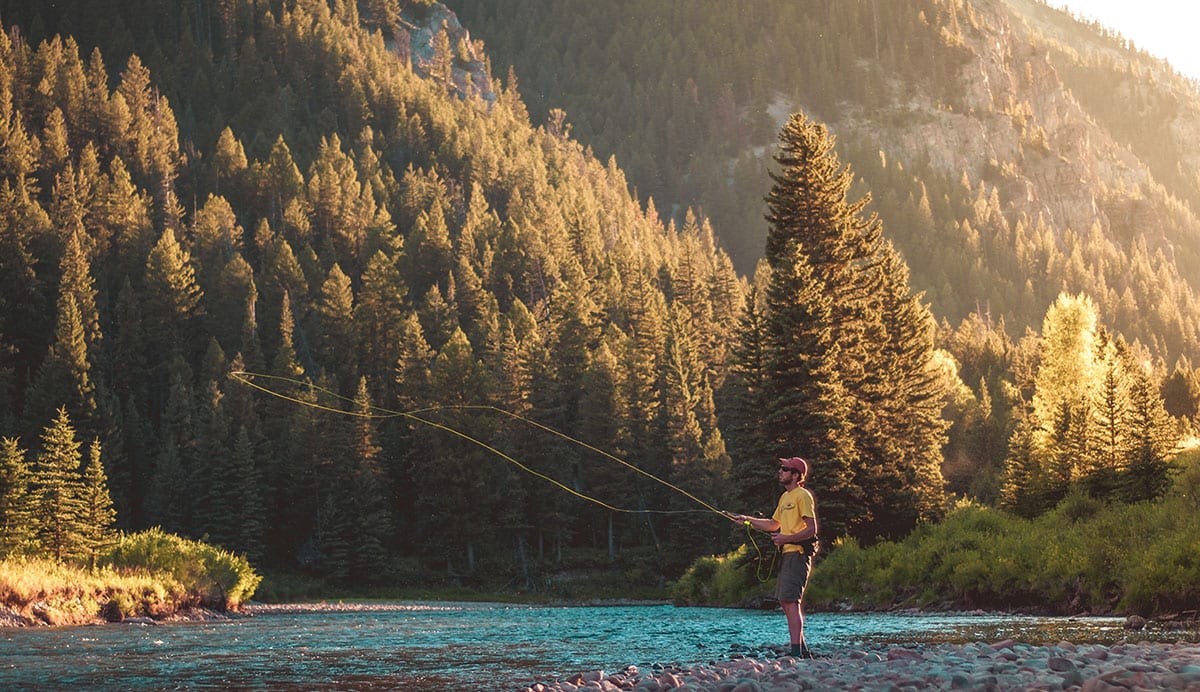As Spring turns into Summer and the last of the snow in the higher elevations begins to melt away, I redirect my focus to the smaller streams and creeks nestled in mountains. Long drives up windy roads offer gorgeous scenic views leading to quiet and often isolated tenkara fishing spots.
Whether the stream is lined with trees and bushes or winds its way through an open meadow, I always recommend taking a stealthy approach. Extra precautions and planning of your movements while on the water will bring you more success when the streams may be crystal clear. Whenever you can, avoid getting in the water. I often try to stay around the outside of the pools and move through them after they have been fished. Try to avoid crossing the creek if you can, but when necessary, cross in a shallow set of riffles after you have cast into all the spots that may hold fish near where you’re crossing. Doing this will help to mask your movements and avoid spooking fish in nearby pools before you get a chance to fish them.
These mountain streams can offer a variety of conditions to fish in. I often find myself climbing through bushes and under tree branches to get to the next pool. These environments can be difficult to cast in, so be sure to check your surroundings before casting! Make sure there are no branches above or behind you, and if possible, check to make sure there are no aquatic plants or reeds coming out of the water where you may get your kebari stuck. I prefer to use slightly shorter lines to help avoid getting my line or kebari stuck in the branches and to lessen the chance of startling any fish due to the line hitting the water as a result of a bad cast from an awkward stance. If the branches don’t allow for an overhead cast, you can always try a side cast or even a bow cast where you pull the casting line back, loading the rod just before you slingshot the fly into the pocket of water that you’re looking to fish.
If you do find yourself on a creek that meanders through a meadow where you don’t have as much tree cover impeding your casts, consider casting from further back. Getting right up to the bank to fish the pool will more often scatter the fish and ruin your chances of catching anything. Crouching further back or behind some sort of cover and placing a delicate, fly-first cast into the pool will be the better option in this case. Also, be aware of your shadow while you move along the banks. Without the tree cover, you may find on other high gradient streams, your shadow cast across the water will alert fish to your presence, often before you even get a glimpse of them.
Where you stand in relation to the water is an important part of a stealthy approach, but it will also influence how you can present the fly. Regardless of whether you’re fishing upstream or downstream, a dead drift is once again the first presentation that I would suggest starting off with. While any of the presentations from my previous post (Dry Fly Fishing) will work on these streams, there are a few others I wanted to suggest for these types of waters.
Placing your kebari in the current will allow for an opportunity to implement an upstream sasoi. By keeping the rod tip high, gently pulling on a submerged fly either upstream or toward the surface to give the kebari a “swimming” motion underwater. This presentation works best with a sakasa kebari or other soft hackle flies and can be used both in a current or in slower moving water at the end of a drift. Be sure to let the kebari sink a bit after the pull, and to keep the pattern you use consistent and predictable for the fish!
When fishing cross-stream or if you’re standing upstream from where you drift the fly, “skating” the fly along the surface can also entice a strike. Gyakubiki can be performed in a few ways. The first of which works better with stiff hackle flies, you steer the fly along the surface, either against the current or towards a slower patch of water outside of the current. The second tends to be more productive with a soft hackle fly. By letting the fly rise and sink near the surface, you just might entice a strike from a waiting trout. You can impart the same sort of pulsing movement used in the upstream sasoi by drawing small circles with the rod tip to further animate the fly.
Be sure top keep the rod tip elevated and the line off the water when using a stiff hackle fly, and slightly elevated and fly ahead of the line when using a soft hackle kebari! It’s also worth noting that this presentation can make it more difficult to set the hook when you do get a strike. Trying to set the hook back upstream will most likely pull the fly away from the fish, so my advice is to draw the rod tip toward one of the banks of the stream that may be clear of branches or bushes.
Fishing these mountain streams can be a fun adventure and a good way to mix it up. I look forward to spending some time on this type of water while the season allows for it, and I encourage you to get out there and fish in the mountains before those seasonal creeks dry up!
Martin Montejano is a Northern California-based fixed-line angler. From spring-fed creeks in the mountains to rivers that run through deep-cut valleys, he fishes a multitude of waters in and around the Sierra Nevadas.
You can follow along as he shares his adventures and experiences at @sagehearttenkara on Instagram.
Martin’s favorite TUSA rod is the ITO™ 13′ / 14’7″ (adjustable)
